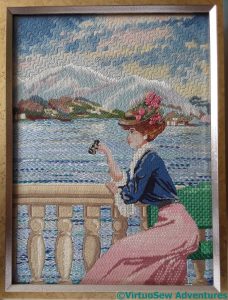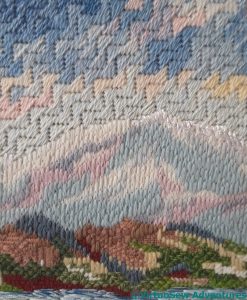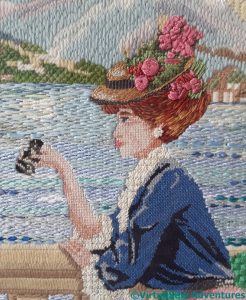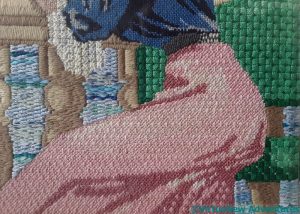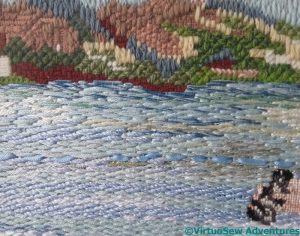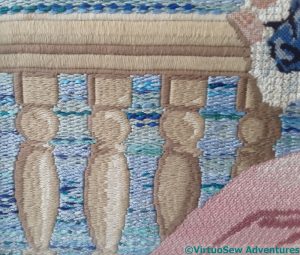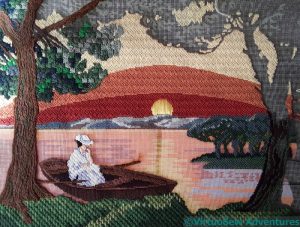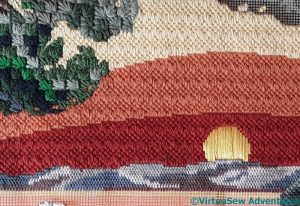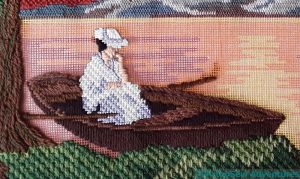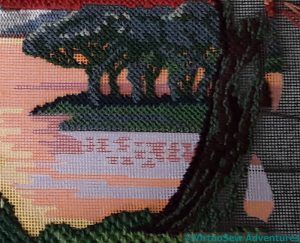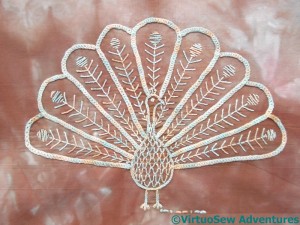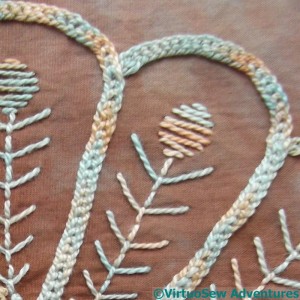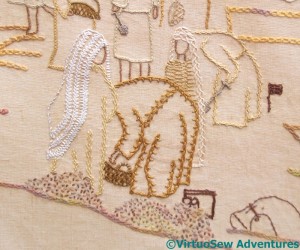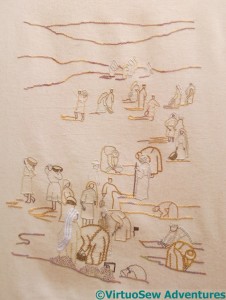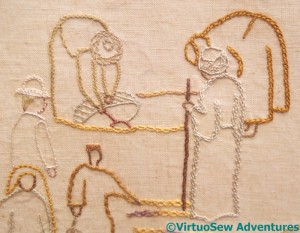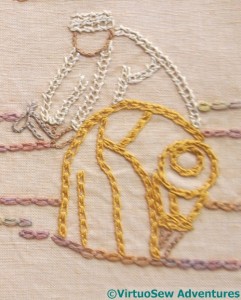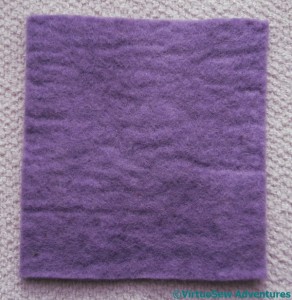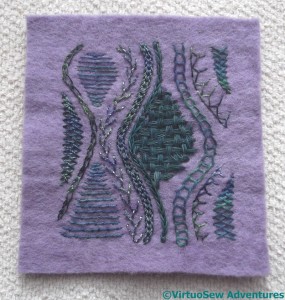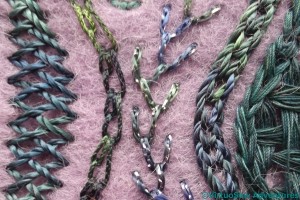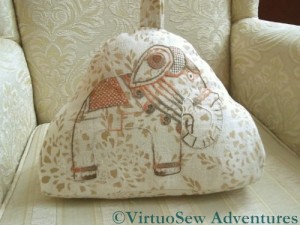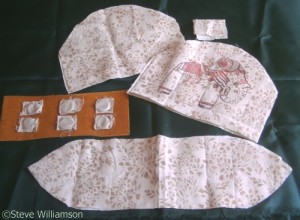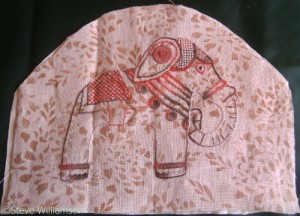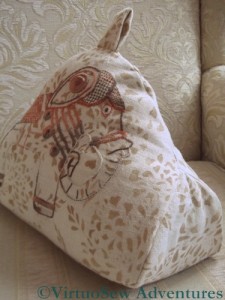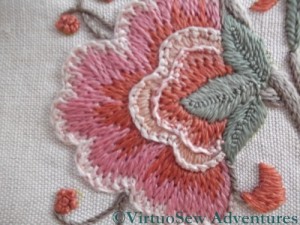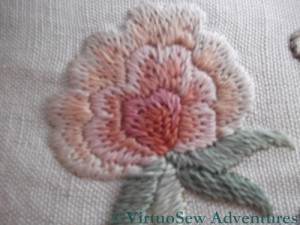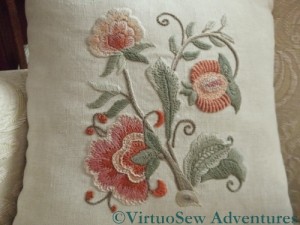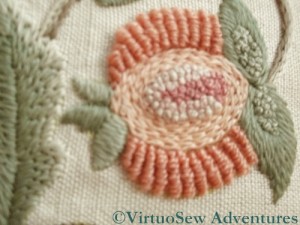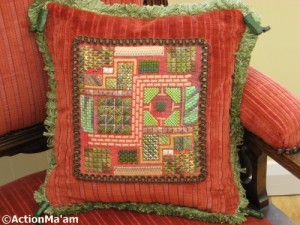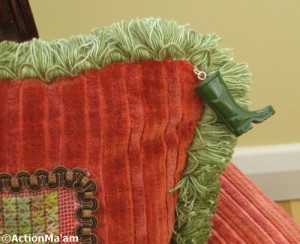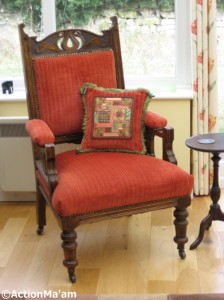Tag: ornamental stitches
Canvaswork again – The Lady By The Lake
This is my second post of canvaswork for Catherine of Hillview Embroidery.
The Lady By The Lake has a much wider range of stitches and threads in it, including blends of stranded cottons, ribbons, and a variety of wools. The canvas is a double thread canvas which makes it possible to separate the threads and work some of the design in petit point.
I wrote a post about the Lady when I first started blogging, but I have a very much better camera now, and an incentive to take the picture down from the wall. Considering the canvas is still under glass I am very pleased with how the photographs turned out. There are enough different materials and textures in the scene to provide a good workout for thread and stitch selection muscles…
The sky and clouds are all Milanese Stitch, worked in blended Persian yarns with three strands in the needle.
The mountains are in Gobelins Stitch in tapestry wool, and the lakeside hills with their forest and villages are a whole tangle of interesting variations of stitch and thread.
The face and arms were worked in petit point, separating the double threads to create single thread canvas, and worked in stranded cottons (blended). The hair (she didn’t have quite such glorious chestnut hair on the painted canvas itself) is also blended stranded cottons, worked in a sort of long and short stitch. The hat has spider’s web stitch roses on it, and she’s wearing large pearl bead earrings.
It was the idea of experimenting with the skirt that attracted me. I used a bordered Hungarian Stitch, worked in three shades of pearl cotton and combining them to create the impression of five shades in the skirt. It worked!
The blouse is also pearl cotton, this time Linen Stitch, which is effectively the back of Basketweave Tent stitch put on the front.
I changed the wooden, slatted backed bench of the canvas into a padded one so that I could do the upholstery in Reversed Mosaic Stitch.
The lake itself took ages to do – row after row of darning stitch using all sorts of ribbons and threads, including some truly ghastly double knitting acrylic yarn which would have made a dreadfully uncomfortable jumper, but made a very good lake surface, with that slight sparkle you get when there’s just enough breeze to move the water.
The balustrade was worked in Soft Embroidery Cotton. I assumed it was something like limestone, and not marble with a polished surface, so the thread needed to be dull to let other elements shine.
Again, click on the pictures to see more and have fun thinking about what I should have done differently!
Canvaswork – Sunset Study
Catherine, of Hillview Embroidery, is doing an RSN canvaswork course at the moment, and commented in a recent post that the folder of photographs of the work of past students at the back of the studio has been really useful, partly for ideas, and partly just to practice analysing designs and stitches.
I have two canvaswork pieces that use ornamental stitches to represent the textures and colours they depict, both worked when I was a teenager. It’s much easier to analyse someone else’s work than your own, so Catherine, this post (and another, as yet unwritten) is for you!
It was actually the sky that made me buy this particular painted canvas (this was long before I’d tried designing my own!). I think the stitch is Hungarian Point, and since the canvas had such a graphic feel, rather than being painterly, I was quite happy to leave the sky with those sharp colour changes. The pattern in fact runs clean through from bottom to top, but that those same colour changes mask the fact. The heather clad hills are in Plaited Stitch, worked small to help them recede. And the foliage of the tree is Ray Stitch. I do wonder whether I should have done the ray stitch facing downwards, but some of the pines have a slight upward curve, so they are staying as they are.
Almost all the threads in this piece were wool. It’s a fairly large gauge canvas, and again, there’s so much flat colour that blends wouldn’t really be suitable.
The lady in the the punt is Soft Embroidery Cotton for her skin and hair, and tubular synthetic for her gown and hat, and the punt is straight stitches in assorted browns. The tree trunk is effectively in stem stitch, and the bushes at the front are interlocking elongated cross stitches. They look surprisingly bushy, don’t they!
The trees in the distance are in Upright Cross Stitch, which makes a good intermediate texture between the bushes at the front and the distant hillside.
And that near tree? That’s one of the reasons I didn’t finish. I found that not only was I not enjoying the combination of stitches, I was running out of the threads and colours I was using. I threw it in the loft in frustration and disgust and only fished it out again after I’d read Catherine’s post.
The sea is another reason. I still haven’t worked out how to do it, and at the moment, I am still not at all sure I want to.
You can click on all the pictures to see them more closely, so Catherine, your homework is to look at them all, think about what you like and what you’d have done differently.
And if any of you have any suggestions for the sea – let me know!
Fine Feathers
Some time ago, I worked on a few designs vaguely inspired by crewelwork, which I submitted to a few companies, none of whom took them. I hadn’t stitched any of them, because I would have used the preferred thread of the company that intended to produce them, but I’ve wanted to…
So when I had another hiatus of inspiration with the Dreams of Amarna, I rummaged for a thread that would work nicely with this over dyed fabric, and had a go. When I originally planned this design, I used peacock colours – blue and green, but I felt that it would be more interesting to work with a single, overdyed thread on the overdyed fabric.
I chose to use Hungarian Plaited Braid stitch for most of the outline. The more I use this stitch, the more I like it. It’s richly textured but at the same time creates a fairly smooth effect, and while – as in this case – it works beautifully in a perlé type thread, it can be very successful, if a little trickier to work, in stranded cotton.
Fly stitch alternating with back stitch gives a bit of lightness to the tail feathers, and I borrowed the idea of the dragon’s scales from Kai Lung of the Golden Hours to create the effect of the down on the peacock’s breast.
I’ve signed him – the Morse code by his feet – but now I’m not at all sure what to do with him!
The View of the Excavation Finished…
The last group took a lot of stitching, restitching, unpicking and restitching. I couldn’t seem to get any of it right, and there are one or two bits I’m still not 100% sure about, even now…
The pale figure, bending over beside the little flag is in Spanish Knotted Feather Stitch, and the nearer bending figure is in Mountmellick Stitch. I was surprised that it was quite so hard to find suitably broad line stitches for the purpose; when you’re looking for characterful narrow stitches, you can only find broad ones, and when you’re looking for broad ones, by some strange alchemy only narrow ones catch your eye…
The creamy white headscarf ran through Crested Chain Stitch (no!) and several stitches I hated so much I didn’t even record them, before I finally settled on three rows of Braid Stitch.
So at last, after much fiddling around, the View Of The Excavation is finished.
I’m fairly happy with it, actually. The trail of people into the distance creates a pleasing pattern, and I think that the alternation of the colours works well. Furthermore, as I wished, the Egyptian labourers and supervisors are the stars. There is a European, but he’s mostly concealed by the others.
There may be a few tweaks – not least I have yet to make sure that it works as a counterpoint to the Map of Amarna – but I think that at last it is finished for the time being!
Still More on the View of the Excavation
As I got nearer the foreground figures, I tried to pick broader stitches, or at least stitches that were a bit more emphatic. This group was great fun to do, starting with the Gufti with his staff of office (Portuguese Knotted Stem!). The Gufti’s robe is Feather stitch, as are some of the twists of his headgear. I concentrated very hard on keeping the stitches even and close so that the “density” of the stitch would be maintained. The one in dark gold is in double interlaced back stitch, except for the top of the headgear, and the waistline – those are whipped backstitch. The other one is in one of the Elizabethan stitches from Jacquie Carey’s book.
I had fun with the supervising excavator – the brim of his solar topee is the Hungarian Braid chain, and I reversed the direction of the chain stitch for the peak of the crown. He’s also the only one with fair hair and pinkish skin, and I dressed him in a pale, tailored jacket.
The two at the front are another mixture of stranded silk, stranded cotton, and round silk thread. The golden veil is coral stitch, and the tunic below it is stranded silk chain stitch, and the dark golden tunic is stranded cotton and twisted chain stitch. I’m trying to make choices of stranded or round yarn that will suit the stitch.
I worked these two diggers on World Embroidery Day – which I hadn’t even known existed until the day before, so I was very glad I was able to sit and stitch!
I went back to my Edith John books for these two. The front one is in Shell Chain stitch, which I first used on the Circle Skirt. I won’t say it’s a favourite, but I have rather taken to it, and it creates an interesting effect.
The one behind is a very peculiar stitch, a combination of twisted chain stitch and open chain stitch. It creates a very square appearance, with the twisted chain alternating from side to side of the open chain, and it is called, rather predictably, Open Twisted Chain Stitch.
More Experiments!
You could be forgiven for thinking that I had finally lost all common sense. We’re all interested in fibre, fabric, and stitch, but even so, expecting you to take an interest in a photograph of a plain piece of felt seems a little extreme.
Especially a very ordinary, single-colour, and entirely unadorned piece of felt.
So what am I up to?
Mischief, of course!
Does it help if I tell you that it’s really quite a thick piece of felt?
Or does it help if I tell you that this is the front?
I bought an “inspiration pack” of threads, and this thick square of felt at “Sewing For Pleasure” a while back, with absolutely no idea of what I expected or intended to do with it.
While I was wondering about it, I remembered reading about a medieval satchel that had been made by sewing the pieces together within the thickness of the leather. I didn’t feel quite willing to attempt something structural, but it gave me the idea of trying to work a sampler of stitches without the back showing.
I even managed to work some of my favourite stitches.
I originally began with a wavy line of Shell Chain stitch, and then built up the design from there. Some of the threads were too heavy to use in this context, and there was a wonderful heavy slub that I couldn’t find a use for (never fear, I will!) but I had great fun alternating texture and shine, space-filling and line, and just playing.
I have absolutely no idea what I’m going to do with it, but I’m rather pleased with how it turned out!
The Elephant Doorstop is Finished.
At last – after some months of puzlement, delay and confusion – and with considerable help from my mother, who was, after all the client, and knew what she wanted! – the Elephant Doorstop is finished!
We decided to make the dorstop vaguely teacosy-shaped, with a flat base, so that it wouldn’t fall over, and a loop to pick it up by so that no one is tempted to pick it up by the embroidery and abrade all that painstaking stitchery.
Once the pieces were cut out, my mother took a picture so you can see what we eventually decided upon. You will notice that there is a piece of buckram to flatten and stiffen the base, and it is being weighted with curtain-weights – small circles of lead held in their own fabric pocket. It’s easy to sew the fabric pocket into a curtain lining, or indeed, onto a piece of bukram, and it is less likely to catch and go astray than if the lead is sewn on like a button or a shisha mirror.
I’ve decided to call him “Kala Nag”, after the elephant in Rudyard Kiplings’s story “Toomai of the Elephants”, in “The Jungle Book”. He’s in ceremonial harness, rather than the working harness of the story, but I think he’s a very grand fellow, and I’m really very pleased with how the embroidery turned out. The variegated threads allow him to disappear slightly against the background in places, which makes for a more visually interesting piece than if he’d been stitched in the same tones throughout.
I propped the finished doorstop up on one of the living room chairs to take some more photos. This one gives you a better idea of the finished three-dimensional article, firmly stuffed with cotton linterfelt and ready to keep doors from swinging. He does a good job, too – those six small pieces of lead are just enough weight to keep him where he belongs.
And when he’s off duty, he sits on a bookshelf, conversing amicably with his older brother, The Elephant of Considerable Charm.
Jane Rainbow Kit – second installment
The raised edges of the petals of this flower are produced by working one row of blanket stitch along the edge and then working detached buttonhole stitch into that. It creates a fairly subtle effect in real life, and it’s always satisfying to see small details like this appearing in kits.
You can also see in this close up that although I was beginning to get to grips with satin stitch, my Long and Short Stitch wasn’t very good.
Really not very good, in fact! The stitching on the second flower looks more like brick stitch. I think this is the only bit of the design I didn’t enjoy doing, and that’s entirely because I simply could not get to grips with Long and Short Stitch. No-one had told me to think “Long and Longer”, which is what has cracked it for me since then. Besides, working a colour change into such narrow rows is not the easiest way to tackle Long and Short stitch!
I did like the rows of stem stitch shading from dark to light that were used for the stems – in fact I used the same technique in the stems on the Piano Shawl. The detail of the end of the stem – concentric rows of stem stitch – was particularly charming.
The leaves in the bottom corner worked well, too. The openwork at the centre of the upper leaf makes a nice contrast with the rest of the design which is very densely stitched.
I did enjoy working this – even if it was finished at the speed of lightening!
Another Long-Ago Project – Jane Rainbow Kit
This crewelwork cushion came from a Jane Rainbow kit, which my parents gave me for Christmas about fifteen years ago. It’s the last kit that anyone’s ever bought for me, because I finished it in short order – it was done by Twelfth Night – and the family felt that it hadn’t kept me out of mischief for long enough! I’ve looked on a couple of needlework shop websites, and it seems that this design is no longer available, which I think is a pity. It was fun to do, and I learnt a couple of variations I’d not come across before.
The pomegranate shows a great variation in height and texture of stitches. I like the way the French knots used in the centre are also used for textured patches on the leaves, although I think I would be inclined, were I to work this today, to use a darker colour in the centre of the pomegranate. The ribbed pattern around isn’t made up of exceptionally long bullion knots, as you might expect, but instead is a sort of opened-out ribbed spiders web stitch. The instructions here said to pack in the stitches as much as possible to get a nicely raised effect. It worked really well – it almost looks padded!
Further Adventures In The Abstract Garden
You may recall that I worked an abstract piece of canvaswork inspired by a vegetable garden. When I’d finished it, I didn’t like it very much, and really didn’t know what to do with it. However, my cousin (who comments here occasionally as Action Ma’am) did not suffer from the same problem. Not only did she like it, she knew what to do with it. I’ve asked her to write up what she did, and here’s what she wrote:
Having commented how the abstract garden canvas reminded me of my veg garden, I was delighted when Rachel offered it to me. I knew exactly what to do – it had already told me it wanted to be on a cushion for the armchair in the conservatory. My guess that the red of the canvas was the same as the red of the upholstery was spot on.
I don’t have a sewing machine, so Fiona my curtain-maker agreed to put the cover together for me. Not having done any needlework for many years, I was quite alarmed at the prospect of “getting it right”. Rachel and I had an email discussion about how to straighten the canvas and apply it to the velvet, handstitching it in place. To emphasize the garden theme, I had chosen some gimp braid to cover the edges of the canvas. The loops of the braid echo the hoops of the iron edging you sometimes find around borders in posh parks and gardens. I also chose some green fringe to define clearly where the cushion ended and the chair began.
Whilst I was still thinking about getting started, Fiona phoned to say she could deliver a bedspread she had been making for me the next day. This was too good an opportunity to miss. I took the afternoon off work, a deep breath, gritted my teeth and leapt in. The stripes on the velvet helped in getting the canvas straight, the braid hid the edge of the canvas, and two hours later, it was ready for Fiona.
Whilst the cover was away being made up, I found a necklace in an accessories shop, with a green wellington boot charm on it. I bought four as a finishing touch.
The abstract garden canvas is now a happy cushion, nestling into the crook of the chair arm, and kicking its welly-booted heels in the air. I don’t think the chair intends letting go of it any time soon!

